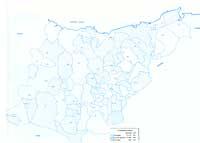Hydrological plans: several reflections
1994/07/01 Antiguedad, Iñaki Iturria: Elhuyar aldizkaria
Making plans is reasonable, especially if made with common sense. But planning doesn't have to be good. Even more so when they are performed in a dispersed manner. The proliferation of plans is also evident with water.
The key to these planes lies in the jump at most. Rational use of water? Yes, of course! Achieving the development of all regions by overcoming imbalances? Of course! Improve management? Harmony with the environment? Of course! But what is in reality? What rational use is aimed at monopolizing water? How to overcome territorial imbalances when the regions where reservoirs are located are pushed to socio-economic ruin (Itoiz, for example)?
A serious Hydrological Plan, in a broad socio-economic ecological context, must combine water demands (demands) with water supplies (available water), both in space and time. And from the beginning, on the same basis, there are differences between plans. When defining future water demands, how many inhabitants are expected to be in each region of the Basque Country in ten years? Twenty years later? What then will be the need for water from the population at home, in industry, in agriculture, in the environment? What?
While Aigues de Barcelona takes as reasonable supply 350 litres/inhabitant/day (even for the future), the PIAS Plan of Gipuzkoa receives a endowment of 440, DOTs of the Basque Government 400, and the North-III Hydrological Plan of 205-405, to name but a few plans. Note that there is more than one new reservoir at stake, depending on the amount you want to define. On the other hand, according to the data released these days by the Bilbao Water Consortium, the water that passes through the networks of Gran Bilbao is “lost” or almost half. However, this organization shows the insatiable dream of the new reservoirs.
In the theme of water there are some slogans that are word of mouth of all, but that have a different reading:
- Without water there is no life. The existence of water does not guarantee life. There is only the quality of life of the peoples around the Urtegiz. Therefore, instead of using water to overcome territorial differences, it is used to increase these differences.
- Without water there is no economic activity. Yes. Therefore, the economic activity that needs water should be concentrated in a place where water is abundant, rather than building cement channels of hundreds of kilometers. And considering that irrigated agriculture is the most in demand (80% in the State), where are the orders of these PACs and GATT foreseeing the future evolution of that demand?
- Water is a scarce resource. Although we all accept with words, it is in fact different, because Prêt plays the pillars of this jeter society. In actions they use water as an abundant resource.
Let us not be told, as has been said recently, that water problems (including plans) are purely technical, since they can only be analyzed in the socio-political context, from the moment the technique to the background. Well, what to think and what to do.

Gai honi buruzko eduki gehiago
Elhuyarrek garatutako teknologia





